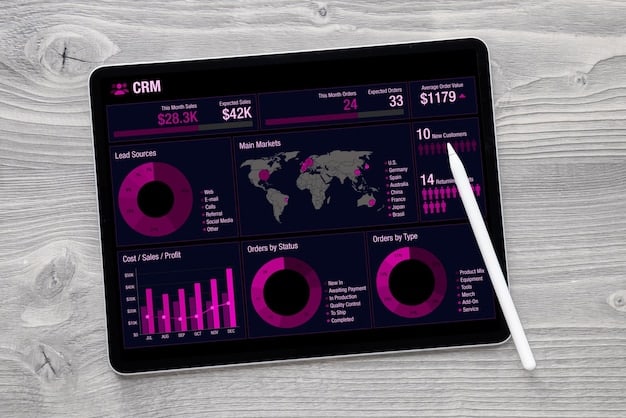Double Your Revenue: E-commerce Growth Strategies for the US in 2025

Doubling your e-commerce revenue in the US by 2025 requires a multi-faceted approach, including optimized marketing, improved customer experience, strategic product selection, and leveraging data analytics for informed decision-making to stay ahead in a competitive market.
Ready to double your revenue: Proven strategies for scaling your e-commerce store in the US in 2025? The e-commerce landscape is constantly evolving, and staying ahead requires innovative approaches. This guide dives into actionable strategies to boost your sales and achieve significant growth.
Strategies for E-commerce Growth in the US Market
The US e-commerce market is one of the largest and most competitive in the world. To succeed, you need a comprehensive strategy that addresses various aspects of your business. This section outlines key areas to focus on for sustainable growth.
Optimizing Your Online Store for Conversions
Conversion rate optimization (CRO) is crucial for turning website visitors into paying customers. A well-optimized store enhances user experience and encourages purchases.
- Improve Website Speed: Fast loading times are essential. Use tools like Google PageSpeed Insights to identify and fix issues.
- Simplify Navigation: Make it easy for customers to find what they’re looking for. Use clear categories and a robust search function.
- Mobile Optimization: Ensure your site is fully responsive and provides a seamless experience on mobile devices.
By focusing on these elements, you can reduce bounce rates and increase the likelihood of visitors making a purchase.

Leveraging Social Media for E-commerce Sales
Social media platforms are powerful tools for driving traffic and generating sales. Effective social media marketing can significantly expand your reach and attract new customers.
- Targeted Advertising: Utilize platforms like Facebook and Instagram to target specific demographics and interests.
- Influencer Marketing: Partner with influencers in your niche to promote your products.
- Engaging Content: Create valuable and engaging content that resonates with your target audience, such as product demos or behind-the-scenes looks.
A well-executed social media strategy can build brand awareness and drive significant sales growth.
In conclusion, optimizing your online store and using social media effectively are critical for achieving sustainable e-commerce growth in the US market.
Enhancing Customer Experience to Drive Repeat Purchases
Customer experience is a key differentiator in the competitive e-commerce landscape. Providing exceptional service and creating a positive experience can lead to increased customer loyalty and repeat purchases.
Personalization Strategies for E-commerce
Personalization involves tailoring the customer experience to individual preferences, which can significantly boost engagement and sales.
- Personalized Product Recommendations: Use data to suggest products based on past purchases or browsing history.
- Customized Email Marketing: Send targeted emails with personalized offers and content.
- Dynamic Website Content: Adjust website content based on user behavior and demographics.
Implementing these strategies can make customers feel valued and increase their likelihood of making repeat purchases.
Streamlining the Checkout Process
A complicated or lengthy checkout process can deter customers from completing their purchase. Streamlining this process is essential for reducing cart abandonment rates.
- Offer Multiple Payment Options: Provide a variety of payment methods, including credit cards, PayPal, and other popular options.
- Guest Checkout: Allow customers to make purchases without creating an account.
- Clear and Transparent Pricing: Display all costs, including shipping and taxes, upfront.
By simplifying the checkout process, you can improve the overall customer experience and increase conversion rates.
In conclusion, focusing on personalization and streamlining the checkout process can significantly enhance customer experience and drive repeat purchases.
Data Analytics for Informed Decision-Making
Data analytics provide valuable insights into customer behavior, market trends, and business performance. Leveraging these insights can help you make informed decisions and optimize your strategies.
Using Google Analytics to Track Key Metrics
Google Analytics is a powerful tool for tracking website traffic, user behavior, and conversion rates. Monitoring these metrics can help you identify areas for improvement.
- Track Conversion Rates: Monitor conversion rates for different products and marketing channels.
- Analyze User Behavior: Understand how users navigate your website and identify areas where they may be dropping off.
- Identify Top Traffic Sources: Determine which marketing channels are driving the most traffic and sales.
By tracking key metrics in Google Analytics, you can gain valuable insights into your business performance and make data-driven decisions.

A/B Testing to Optimize Performance
A/B testing involves comparing two versions of a webpage or marketing campaign to determine which performs better. This can help you optimize your strategies and improve results.
- Test Different Headlines and Copy: Experiment with different headlines and ad copy to see which resonates best with your audience.
- Test Different Call-to-Action Buttons: Try different colors, sizes, and wording for your call-to-action buttons.
- Test Different Website Layouts: Experiment with different layouts and designs to see which leads to higher conversion rates.
By conducting A/B tests, you can continuously optimize your website and marketing campaigns for maximum performance.
In conclusion, leveraging data analytics and conducting A/B tests are essential for making informed decisions and optimizing your e-commerce strategies.
Expanding Your Product Line Strategically
Expanding your product line can attract new customers and increase sales. However, it’s important to do so strategically to ensure that new products align with your brand and target audience.
Identifying Untapped Market Niches
Identifying untapped market niches can give you a competitive advantage and allow you to cater to specific customer needs. Researching market trends and customer preferences is crucial for identifying these niches.
Conducting Market Research to Find New Opportunities
Market research involves gathering and analyzing data about your target market, competitors, and industry trends. This can help you identify new opportunities for growth and expansion. Consider these strategies:
- Analyzing Competitor Offerings: Look at what your competitors are doing and identify gaps in the market.
- Customer Surveys: Gather feedback from your current customers to understand their needs and preferences.
- Trend Analysis: Stay updated on the latest industry trends and emerging product categories.
In closing, strategic product expansion and diligent market research ensures alignment of new additions with brand identity and satisfies customer demands. By using this information, you can make informed decisions about which products to add to your line.
Streamlining Operations and Supply Chain Management
Efficient operations and supply chain management are crucial for delivering products to customers quickly and cost-effectively. Streamlining these processes can improve customer satisfaction and reduce costs.
Inventory Management Techniques for E-commerce
Effective inventory management is essential for ensuring that you have the right products in stock at the right time. Implementing inventory management techniques can help you avoid stockouts and reduce holding costs. Strategies to consider encompass:
- Just-in-Time Inventory: Receive inventory only when you need it to minimize holding costs.
- ABC Analysis: Categorize inventory based on its value and prioritize management efforts accordingly.
- Inventory Forecasting: Use data to predict future demand and adjust inventory levels accordingly.
Optimizing Shipping and Fulfillment Processes
Shipping and fulfillment processes are key components of the customer experience. Optimizing these processes can improve delivery times and reduce shipping costs. Optimize by:
- Automated Fulfillment Systems: Use technology to automate order processing and fulfillment.
- Partnering with Third-Party Logistics (3PL) Providers: Outsource fulfillment to a 3PL provider to leverage their expertise and infrastructure.
- Negotiating Shipping Rates: Negotiate with carriers to get the best possible rates and delivery times.
In conclusion, optimizing shipping and fulfillment, together with inventory management, drives operational efficiencies and elevates overall customer satisfaction.
Building a Strong Brand Identity and Presence
A strong brand identity can differentiate your e-commerce store from the competition and build customer loyalty. Building a recognizable and trustworthy brand is essential for long-term success.
Developing a Unique Value Proposition
A unique value proposition (UVP) communicates the unique benefits that your e-commerce store offers to customers. Your UVP should clearly articulate why customers should choose you over your competitors.
Creating Consistent Branding Across All Channels
Maintaining consistent branding across all channels builds brand recognition and trust. Consistency in visuals, messaging, and customer service helps create a cohesive brand experience.
Consistently branding:
- Visual Consistency: Use the same logo, colors, and fonts across all marketing materials and website pages.
- Messaging Consistency: Ensure that your brand messaging is consistent across all channels.
- Customer Service Consistency: Provide consistent and high-quality customer service across all channels.
In closing, building a strong brand identity through a unique value proposition and consistent branding establishes lasting customer loyalty and distinguishes your e-commerce store from prevailing competitors.
| Key Point | Brief Description |
|---|---|
| 🚀 Optimize Your Store | Enhance speed, navigation, and mobile experience for higher conversions. |
| 📣 Leverage Social Media | Use targeted ads, influencers, and engaging content to drive sales. |
| 📊 Use Data Analytics | Track metrics and A/B test to make data-driven decisions. |
| 📦 Streamline Operations | Optimize inventory, shipping, and fulfillment for better customer experience. |
FAQ Section
▼
Start by optimizing your website’s speed and ensuring it is mobile-friendly. Slow loading times and poor mobile experience can drive customers away quickly.
▼
Utilize targeted advertising on platforms like Facebook and Instagram, partner with influencers, and create engaging content. This will target a wider audience and lead to more sales.
▼
Data analytics provide insights into customer behavior, market trends, and business performance. This will allow you to make informed decisions about your strategies.
▼
A/B testing involves comparing 2 versions of a webpage or marketing campaign to determine which performs better. Helps you optimize your approaches from real metrics.
▼
Consider automated fulfillment systems, partnering with 3PL providers, and negotiating shipping rates with carriers to achieve better delivery times & reduced costs.
Conclusion
By implementing these proven strategies for scaling your e-commerce store in the US in 2025, you can gear yourself toward significant revenue growth. Consistent effort across optimizing your online store, customer experience, leveraging data analytics, and expanding your product line will enable you to thrive in an increasingly competitive market and achieve your business goals.





